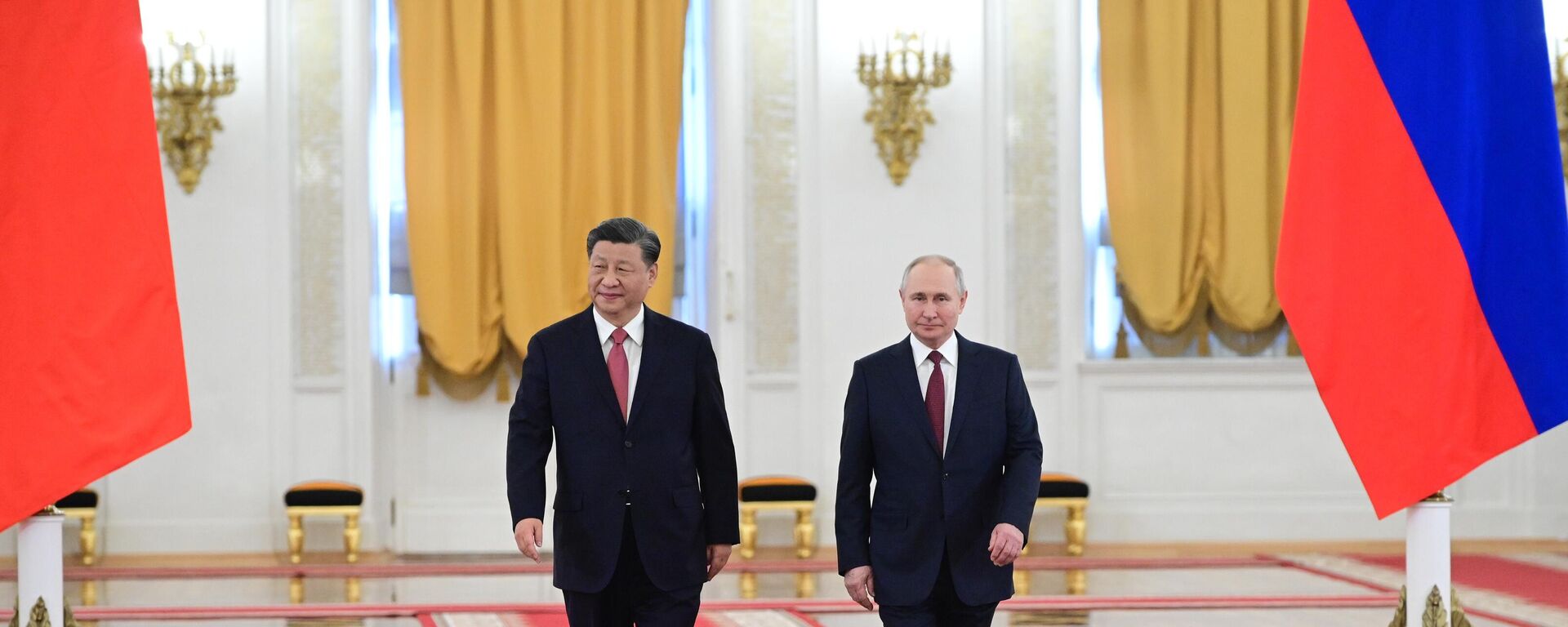https://en.sputniknews.africa/20230927/1062394908.html
'Eroding Dollar Dominance': European Research on Increasing Use of Yuan in Russia-China Trade
'Eroding Dollar Dominance': European Research on Increasing Use of Yuan in Russia-China Trade
Sputnik Africa
De-dollarization has been a key agenda item at the recent BRICS summit, which included discussing ways to move away from the dollar by boosting trade in local... 27.09.2023, Sputnik Africa
2023-09-27T15:24+0200
2023-09-27T15:24+0200
2023-09-27T16:51+0200
russia
china
united states (us)
international
ditching dollar
de-dollarization
alternative currency
economy
west
brics
https://cdn1.img.sputniknews.africa/img/07e7/09/1b/1062395078_0:129:3187:1921_1920x0_80_0_0_23eea7f8a8162346e60cc4512606db2a.jpg
Increased use of the yuan in sweeping trade between Russia and China is undermining the dominance of the US dollar, new European research has confirmed."Over the course of 2022, the share of Russia’s imports invoiced in yuan (CNY) increased by 17 percentage points," the research paper by the European Bank for Reconstruction and Development (EBRD) stated. By the end of last year, 20 percent of Russia’s imports were invoiced in yuan. Furthermore, the use of yuan to settle imports from third countries also surged to reach 5 percent, the paper added.The study referred to the Western sanctions - imposed against Moscow over Ukraine and designed to “cripple” the Russian economy, a plan that backfired on a number of levels. After Washington and its allies “upended trade routes” as part of the restrictions, trade surged between Russia and China to new levels.Furthermore, sanctions had “given impetus to countries to think about diversifying invoicing currencies, and in the long-term this could erode the dominance of the dollar,” EBRD Chief Economist Beata Javorcik, co-author of the paper, was quoted as saying.Amid increased “weaponization” of the greenback by the US, Moscow and Beijing, like many other countries, opted to settle a much larger share of their mutual trade in the Chinese currency, while seeking to ditch the US dollar. Thus, the yuan accounted for 34 percent of Russian imports in July, and made up 25 percent of exports, according to figures by Moscow’s Central Bank.Furthermore, the Chinese currency is being used increasingly more by third countries that have “swap lines” with the People’s Bank of China, and have failed to be coerced into joining the West’s punitive and self-harming sanctions.The figures cited in the analysis only highlight the process that has been gaining momentum throughout the past months - de-dollarization is happening at a steady rate within BRICS and in the global economy. The US dollar’s slow decline as the world's fiat currency and central bank reserve holdings accelerated in 2022, when Washington and its allies resorted to sanctions against Russia. The nearly 15,000 new sanctions targeting Moscow, along with a decision to freeze a portion of Russia’s foreign reserves, allowed major non-Western countries, including even long-time traditional US allies and partners, finally to wake up to the potential dangers that staking all on the greenback was fraught with. That is when other currencies for trade, such as the yuan, were thrown into focus.Western restrictions served to ignite greater trade in local currencies between Moscow and its partners. The ruble’s share in payments for Russian exports has topped 50 percent, and accounts for more than a third of Russia’s overall foreign trade, acting Federal Customs Service chief Ruslan Davydov revealed earlier this month.Furthermore, at the recent BRICS summit in Johannesburg, members voiced their determination to increase use of local currencies in trade and financial transactions, both between BRICS members and with their partners. As for China, Russia's trade with the Asian behemoth surged by 36.5 percent to $134.1Bln in January to July 2023 , China's General Administration of Customs said earlier in the year. During the period, China imported goods to Russia worth $62.5Bln, an increase of 73.4 percent on the same period in 2022, and deliveries from Russia to China increased by 15.1 percent to $71.6Bln. Separately, in July, trade between the two countries amounted to $19.5Bln: Russia supplied goods worth $9.2Bln to China and China supplied goods worth $10.3Bln to Russia.Over the same period, US-China trade decreased 15.4 percent to $381.5Bln, according to China's General Administration of Customs. Chinese exports to the US in the reporting period shrank 18.6 percent year-on-year to $281.7Bln.Despite attempts by some Western countries to interfere, Russian-Chinese trade and economic cooperation continues to grow, Russian Foreign Minister Sergey Lavrov emphasized in June, in a video message at the opening of the conference 'Russia and China: Cooperation in the New Era' in Beijing.
https://en.sputniknews.africa/20230924/1062328707.html
https://en.sputniknews.africa/20230912/trade-between-russia-china-could-reach-200bln-as-early-as-2023-putin-says-1062047738.html
russia
china
united states (us)
west
Sputnik Africa
feedback@sputniknews.com
+74956456601
MIA „Rossiya Segodnya“
2023
News
en_EN
Sputnik Africa
feedback@sputniknews.com
+74956456601
MIA „Rossiya Segodnya“
Sputnik Africa
feedback@sputniknews.com
+74956456601
MIA „Rossiya Segodnya“
russia, china, united states (us), international, ditching dollar, de-dollarization, alternative currency, economy, west, brics, ruble, yuan
russia, china, united states (us), international, ditching dollar, de-dollarization, alternative currency, economy, west, brics, ruble, yuan
'Eroding Dollar Dominance': European Research on Increasing Use of Yuan in Russia-China Trade
15:24 27.09.2023 (Updated: 16:51 27.09.2023) De-dollarization has been a key agenda item at the recent BRICS summit, which included discussing ways to move away from the dollar by boosting trade in local currencies such as the Chinese yuan. Discussions about moving away from the dollar are also fueled by the precarious position of the US currency in the world as a recession looms.
Increased use of the
yuan in sweeping trade between Russia and China is undermining the
dominance of the US dollar, new European research has confirmed.
"Over the course of 2022, the share of Russia’s imports invoiced in yuan (CNY) increased by 17 percentage points," the
research paper by the European Bank for Reconstruction and Development (EBRD) stated. By the end of last year,
20 percent of Russia’s imports were invoiced in yuan. Furthermore, the use of yuan to settle imports from third countries also surged to reach
5 percent, the paper added.
The study referred to the
Western sanctions - imposed against Moscow over Ukraine and designed to “cripple” the Russian economy, a plan that
backfired on a number of levels. After Washington and its allies “upended trade routes” as part of the restrictions, trade surged between Russia and China to new levels.
Furthermore, sanctions had “given impetus to countries to think about diversifying invoicing currencies, and in the long-term this could erode the dominance of the dollar,” EBRD Chief Economist Beata Javorcik, co-author of the paper, was quoted as saying.
"The use of the yuan as a vehicle currency increased on average by an extra 4 percentage points among trading partners that have an active yuan swap line," added the study.
Amid increased “weaponization” of the greenback by the US, Moscow and Beijing, like many other countries, opted to settle a much larger share of their mutual trade in the Chinese currency, while seeking
to ditch the US dollar. Thus, the
yuan accounted for 34 percent of Russian imports in July, and made up 25 percent of exports, according to figures by Moscow’s Central Bank.
Furthermore, the Chinese currency is being used increasingly more by third countries that have “swap lines” with the People’s Bank of China, and have failed to be coerced into joining the West’s punitive and self-harming sanctions.
"Thus, while dominance of the US dollar (USD) makes international sanctions more effective, as payments denominated in USD need to be cleared through the US banking system, economic sanctions may encourage a shift away from USD as a vehicle currency thus eroding the USD dominance," stated the EBRD research.
The figures cited in the analysis only highlight the process that has been gaining momentum throughout the past months - de-dollarization is happening at a steady rate within BRICS and in the global economy.
The US dollar’s slow decline as the world's fiat currency and central bank reserve holdings accelerated in 2022, when Washington and its allies
resorted to sanctions against Russia. The nearly 15,000 new sanctions targeting Moscow, along with a decision to freeze a portion of Russia’s foreign reserves, allowed major non-Western countries, including even long-time traditional US allies and partners, finally to wake up to the potential dangers that staking all on the greenback was fraught with. That is when other currencies for trade, such as the yuan, were thrown into focus.
Western restrictions served to ignite greater trade in local currencies between Moscow and its partners. The ruble’s share in payments for Russian exports has topped 50 percent, and accounts for more than a third of Russia’s overall foreign trade, acting Federal Customs Service chief Ruslan Davydov revealed earlier this month.
Furthermore, at the recent
BRICS summit in Johannesburg,
members voiced their determination to increase use of local currencies in trade and financial transactions, both between BRICS members and with their partners.
As for China, Russia's trade with the Asian behemoth surged by 36.5 percent to $134.1Bln in January to July 2023 , China's General Administration of Customs said earlier in the year. During the period, China imported goods to Russia worth $62.5Bln, an increase of 73.4 percent on the same period in 2022, and deliveries from Russia to China increased by 15.1 percent to $71.6Bln. Separately, in July, trade between the two countries amounted to $19.5Bln: Russia supplied goods worth $9.2Bln to China and China supplied goods worth $10.3Bln to Russia.
Over the same period, US-China trade decreased 15.4 percent to $381.5Bln, according to China's General Administration of Customs. Chinese exports to the US in the reporting period shrank 18.6 percent year-on-year to $281.7Bln.
Despite attempts by some Western countries to interfere, Russian-Chinese trade and economic cooperation continues to grow, Russian Foreign Minister Sergey Lavrov emphasized in June, in a video message at the opening of the conference 'Russia and China: Cooperation in the New Era' in Beijing.



